So I'll start with this picture.
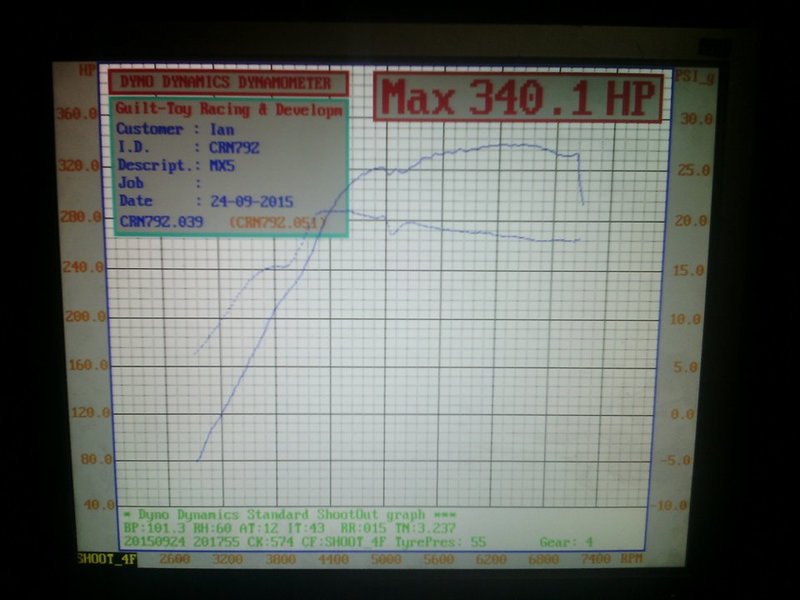
This is Ians car running in the upper limits of the turbochargers efficiency, a little over 20psi.
Now that I have your attention I wanted to write a little about the journey that was building this new setup.
Ians car first came to me with a stock AVO kit, using a GT2554r, and a Megasquirt 3. It made 220rwhp and was a lot of fun.
He talked to me about going bigger and we came up with a solution for his future, his short term plan was to have a 3" stainless exhaust fitted, a different intake, and to fit a bigger GT2860rs turbocharger (aka disco potato).
After he did these mods he brought it to me to get it set up and tuned and unfortunately on the dyno the engine made some bad noises and the decision was made on the spot to complete the plans we had discussed. The noises started just minutes into the tuning, at very low load and rpm (we were simulating a 2000rpm cruise condition). The motor was quickly stripped down and we found some marks on top of one piston, it appears as though something made its way into an intercooler pipe during the turbocharger and exhaust swap and went straight out through the exhaust causing little damage, but we had already come so far.
The engine was built with as many original components as we felt comfortable using, including the stock pistons, crank, the entire head, inlet manifold and fuel rail. We upgraded to some very cost effective conrods, and a boundary engineering street/strip oil pump, and fitted ARP hardware everywhere, a clutch was chosen and ID1000 injectors. A total of 16 hours was spent in assembly alone on top of a light hone, hotwash, the head was refreshed and many other little details.
Going to E85 was a big decision and after discussing many times how it can be implemented, we chose to install a full flex fuel setup allowing the use of any blend of fuel from 98 octane to E85. A Continental flex fuel sensor from a late model Commodore was fitted underneath the fuel tank. This sensor runs on 12V powered by the ecu, and sends a pulsed signal back to the ecu. The voltage of the pulses tells the ecu the percentage of ethanol in the fuel and the length of the pulses tells the ecu the temperature of the fuel. The Ecu then interpolates between 2 maps depending on the blend and spits out the right fueling, ignition timing, and duty cycle for the boost control solenoid. This means that any blend can be used, and the more E85 in the tank the more power.
We installed this sensor using quick connectors, which just makes working on the fuel system about 5 times less painful, instead of a specialized tool to remove the connections, you just push a button on the side and they slide off, they seal with a viton O Ring and work exceptionally well. The fuel filter was also changed over as a precaution.
Here is a photo of it installed.
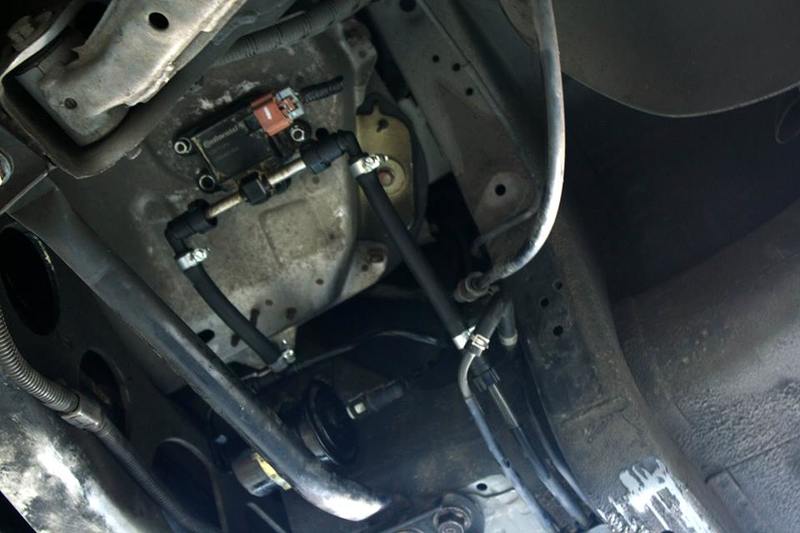
In order for the flex fuel system to work on this particular ECU, some mods internally were required.
Initially it did not work and I wasnt sure why, so while I was awaiting a return email to solve the issue we tuned it on both fuels(98 and E85). The sensor merely helps the ecu figure out which map to use (or what blend of each map) by telling the ecu the percentage of ethanol, and since we knew the percentage (None in 98 and 80%+ in E85) we could tune the car and run it in dual map mode for the time being.
The car initially make a respectable 285rwhp on E85, but it was short of what I had expected. It also had a bit too much blowby and unfortunately an oil leak.
After some discussion I built a much better air intake and a catch can was built also.
The catch can itself has a single tubular baffle, and is filled with steel wool, it also has a drain plug.
Seeing as how it was breathing fairly heavily the catch can was taken pretty seriously and we went straight for the USA style big turbo miata design, this upgrades the single 6mm port on the passenger side of the cam cover to a pair of 12mm ports running to a single catch can, and then vented back into the turbocharger intake. Not only is a pair of AN fittings welded to the cam cover for the hoses, the inside of the cam cover had some work done too.
The original baffle cover which doesnt allow any gases to flow through it was drilled, and below it a piece of Scotch-Brite was added. The holes allow much higher flow of blowby to the catch can, and the Scotch-Brite stops oil from sloshing out into the hoses.
Photos of both the catch can and new intake are below.
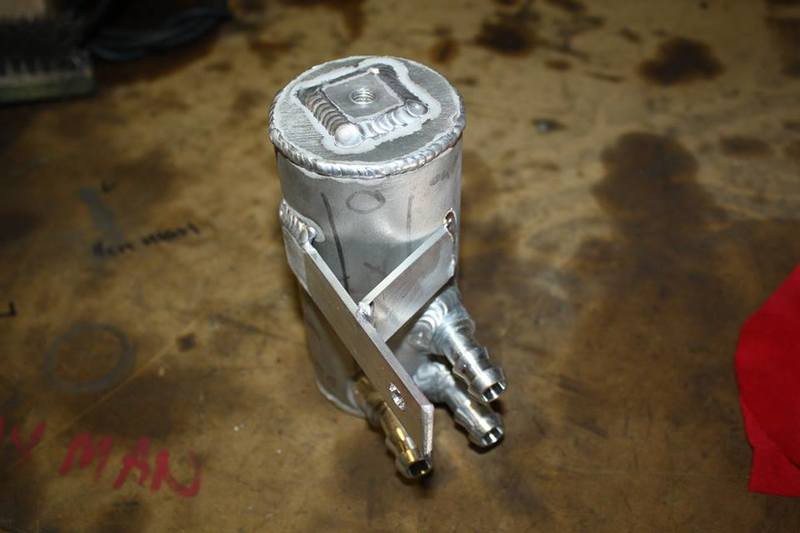
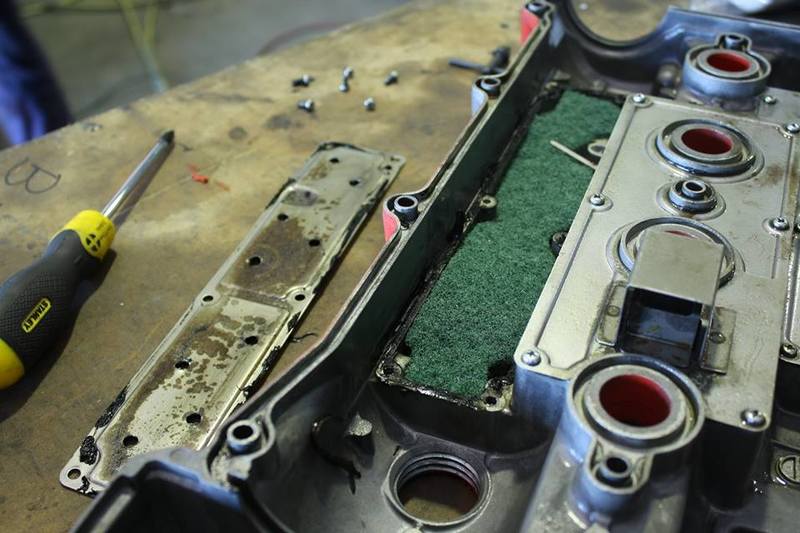

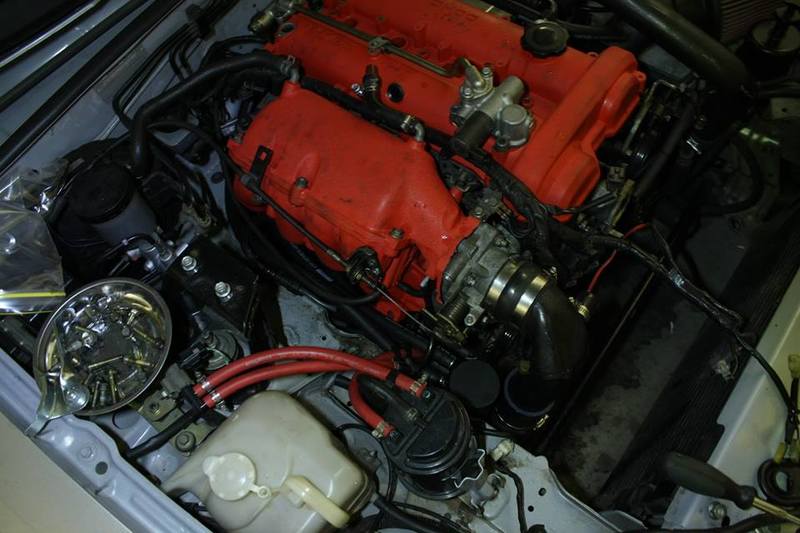
The leak was fixed and the car was tuned again, making 305rwhp.
The car was given back to Ian for a few days still with no flex fuel, and still with no tuning outside of warm operating temperature power tuning. I knew that he would find many flaws and asked him to note them so I could do a really excellent job of getting it to drive just right.
He found a cut in an intercooler hose that no one had seen before and we werent sure if it was new or old so the decision was made to get it back on the dyno after the flex fuel was fixed, and confirm everything was operating correctly, from the catch can, to the intake, the flex fuel and the reasonably sophisticated boost control system I use.
Unfortunately, another oil leak had sprung up, and it needed half a days work to sort it out. I built the engine so of course I fixed these leaks for free, and I fitted a new rear main seal despite the old one being only a couple of hundred Kms old, its just the right thing to do, if you can see a front of rear main seal, you typically change it.
Reverant (he makes the MS3 special editions like Ians)got back to me about the flex fuel not working, and as it turns out I had to use a specific earth not just any ecu earth for it to work, and I wasnt told, so I changed it over, poured some different fuels back and forth into the car to test it was working, then went ahead and set up the fuel blend curve, the ignition blend curve, and the boost blend curves. These are algorithms built into the tuning software which allow you to choose how the ecu interpolates the multiple tuning tables according to the info it receives from the ethanol sensor (flex sensor).
We got it back onto the dyno and confirmed everything was good and readjusted the boost curve now that it no longer had a split intercooler pipe. The 98 octane tune was done as a valet tune, no boost control effort (this means the boost controller was set to 'zero', this is the least boost possible on this setup, around 11psi) and it was tuned a little rich and with very low timing.
Here is what it makes with 100% gasoline in the tank.

We then drained the fuel, washed some E85 around the tank, and drained it again, then filled it completely with E85.
We reset the boost curves and paid specific attention to the torque to give Ian the exact result he wanted, it was a pretty long process especially as we added different fuel blends to make sure the torque and fuel curves would be consistent with what they needed to be to give the car the right feel no matter the fuel composition.
The top photo is a run we did as part of our testing on E85, as you can see everything is flowing like it should and it makes way more torque and power than is necessary and there is plenty of time to turn it up in the future if Ian feels the need.
Here is his final run, as the car was given back.
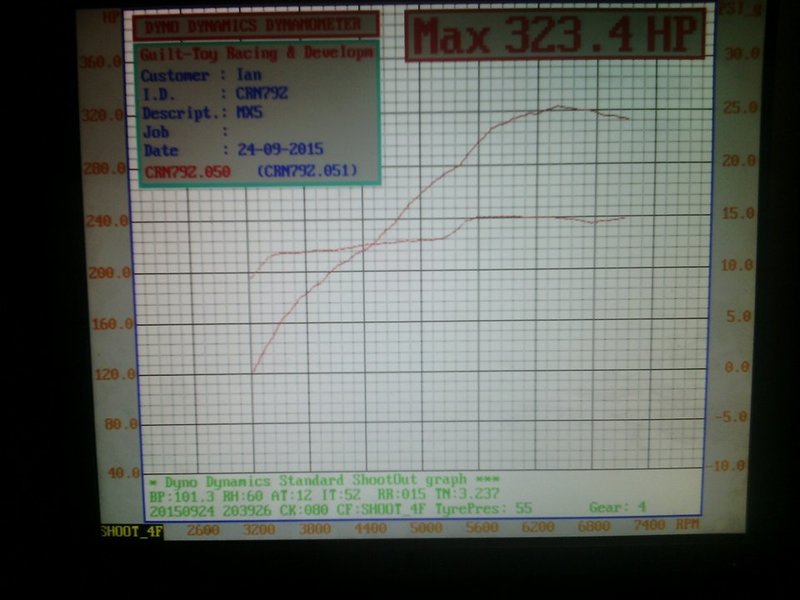
You can see that the power is smooth and very consistently increasing, And you can see that the boost is not flat. This is part of the way I tune these cars to get nice driveability.
Ian then asked me to take the car home for a few days and make sure that it behaved from cold starts through to hot operating temperature on 98, E85, and different blends, and make any necessary changes to the tune to get it right. I have been happy with it for a day or 2 and he has got the car back today.
I am considering doing a big write up on flex fuel tuning soon BTW. And if anyone has any questions, please feel free to ask them here.
Dann







